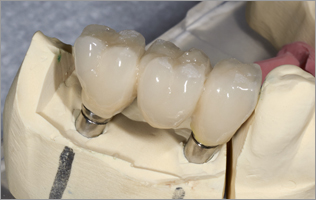Dental Bridges
A dental bridge is a custom-made false tooth or teeth, which are permanently placed between two healthy teeth, filling in the area left by a missing tooth or teeth. The bridge is held in place by porcelain crowns placed on the healthy teeth on each side of space to be filled.
Types of Dental Bridges: There are three main types of bridges
1. Traditional bridges involve creating a crown for the tooth on either side of the missing tooth, with a pontic inbetween. Traditional bridges are the most common type of bridge and are made of either porcelain fused to metal or ceramics.

2. Cantilever bridges are used when there are adjacent teeth on only one side of the missing tooth or teeth.
3. Maryland bonded bridges (also called a resin-bonded bridge or a Maryland bridge) are made of porcelain teeth and gums supported by a metal framework. Metal wings on each side of the bridge are bonded to your existing teeth.
There are three basic types of materials for dental bridges
1. Porcelain fused to metal dental bridges
2. All porcelain dental bridges
3. All metal dental bridges (Gold)
The all porcelain dental bridges and porcelain fused to metal (PFM) dental bridges are tooth colored bridges. The dentist can help you decide which to be used based on the location of the missing tooth (teeth) and its function. PFM dental bridges are usually used to restore back teeth where the forces of chewing and grinding are strongest. All porcelain dental bridges are the most aesthetic and are used almost exclusively for front teeth where the need for strength is not as critical. Gold dental bridges are the most durable and offer the most precise fit. Gold dental bridges do not chip.

Benefits of Dental Bridges
– Restore your smile
– Restore your ability to properly chew and speak
– Maintain the shape of your face
– Distribute the forces in your bite properly by replacing missing teeth
– Prevent remaining teeth from drifting out of position
– Maintain good oral hygiene
Who is a candidate for dental bridges?
If you have missing teeth and have good oral hygiene practices, you should discuss this procedure with your dentist. If spaces are left unfilled, they may cause the surrounding teeth to drift out of position. Additionally, spaces from missing teeth can cause your other teeth and your gums to become far more susceptible to tooth decay and gum disease.
How Do I Care for My Bridges?
It is important to keep your remaining teeth healthy and strong as the success of the bridge (depending on the type selected) depends on the solid foundation offered by the surrounding teeth. Brushing twice a day and flossing daily helps prevent tooth decay and gum disease that can lead to tooth loss. Your dentist or dental hygienist can demonstrate how to properly brush and floss your teeth. Keeping a regular cleaning schedule will help diagnose problems at an early stage when treatment has a better prognosis. Selecting a balanced diet for proper nutrition is also important.






